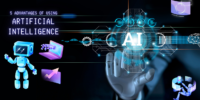Welcome to the era where artificial intelligence (AI) transforms the landscape of user interface (UI) and user experience (UX) design. In this article, we’ll explore quick tips to harness the power of AI-driven design, creating delightful and intelligent digital experiences for users.
The AI Design Revolution: A Paradigm Shift
Embrace the AI design revolution, marking a paradigm shift in the way we approach UI/UX. AI brings forth a new era of intelligent design, where algorithms learn, adapt, and enhance the user experience based on real-time data and user behavior.
Personalization Prowess: Tailoring Experiences for Individuals
Unlock the personalization prowess of AI to tailor experiences for individual users. Leverage machine learning algorithms to analyze user preferences, behaviors, and interactions, delivering personalized interfaces that resonate with each user on a deeper level.
Smart Content Curation: Anticipating User Needs
Anticipate user needs with smart content curation powered by AI. Algorithms can analyze user interactions and preferences to curate content in real time, ensuring that users are presented with relevant information, products, or services that align with their interests.
Predictive User Flow: Guiding Intuitively ♂️
Guide users intuitively with predictive user flow. AI algorithms can predict user actions and preferences, optimizing the flow of the interface to provide a seamless and intuitive journey. This anticipatory design minimizes friction and enhances the overall user experience.
Automated Accessibility: Inclusive Design Excellence ♿
Excel in inclusive design with automated accessibility powered by AI. Ensure your UI/UX is accessible to all users, including those with diverse abilities. AI can analyze content and automatically generate accessible elements, fostering a design that prioritizes inclusivity.
Emotion Recognition Elegance: Designing for Feelings
Design for feelings with emotion recognition elegance. AI-driven tools can analyze facial expressions, voice tone, and user interactions to gauge emotional states. Tailor the UI/UX to respond empathetically, creating a more emotionally resonant digital experience.
Dynamic User Interfaces: Adapting in Real Time
Create dynamic user interfaces that adapt in real time. AI algorithms can analyze user behavior and adjust the UI elements, layouts, and content dynamically. This adaptability ensures a fluid and responsive experience across various devices and scenarios.
Feedback Analysis Finesse: Enhancing Iterative Design
Enhance iterative design with feedback analysis finesse. AI tools can analyze user feedback, reviews, and engagement data to provide valuable insights for design improvements. This data-driven approach ensures that design iterations are informed and impactful.
Human-AI Collaboration: Augmenting Creativity
Augment creativity through human-AI collaboration. AI can assist designers by generating design suggestions, automating repetitive tasks, and providing data-driven insights. This collaborative approach unleashes the full creative potential of designers while leveraging the efficiency of AI.
Ethical AI Design Guidelines: Designing with Integrity
Design with integrity by following ethical AI design guidelines. Ensure that AI-driven design prioritizes user privacy, transparency, and fairness. Upholding ethical standards in AI design is crucial for building trust and fostering a positive user experience.
Conclusion: Crafting Intelligent Design Futures
As we navigate the landscape of AI-driven design, the future holds endless possibilities for crafting intelligent and delightful digital experiences. By embracing personalization, smart content curation, predictive user flow, automated accessibility, emotion recognition, dynamic interfaces, feedback analysis, human-AI collaboration, and ethical design principles, we pave the way for a design future that seamlessly blends human creativity with AI intelligence. May your designs be intelligent, your experiences be delightful, and your users be captivated by the magic of AI-driven UI/UX!








